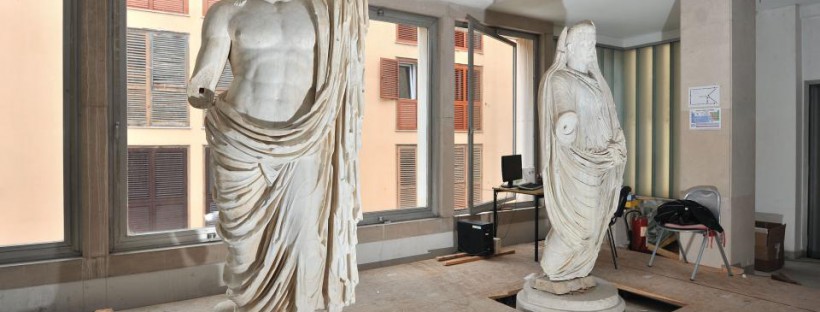There are few people who have not heard of Zadar’s Permanent Exhibition of Ecclesiastic Art in the Benedictine Convent of St. Mary in Zadar, also known as “Gold and Silver of Zadar”, almost as valuable St. Francis’ Monastery’s collection or newly opened and fully restored Treasury of the Serbian Orthodox Church of St Elias the Prophet in Zadar.
Churches of St. Donatus, St. Simeon, St. Grisogono and the Cathedral of St. Anastasia are famous worldwide and this valuable group of ecclesiastical monuments is of utmost importance for both Zadar’s and Croatia’s history. However, we will here concentrate on Zadar’s cultural heritage that is still not that popular or is just waiting for its chance to be properly presented to the public (such as Zadar’s State Archives where 500 years of history records of Dalmatia’s capital are stored), that is, those cultural monuments that have been reinvented and restored as of lately to become a new part of the Zadar cultural offer. So let’s start from the beginning…
After long preparations and struggles, the Archaeological Museum in Zadar has finally opened its magnificent Antiquity Collection to the public last year. The so-called Group of Emperors, consisting of four statues of Roman Emperors – Gaius Julius Caesar, Tiberius, Augustus and probably Caligula, holds the central place in the exhibition. Emperor Augustus’ statue, which the international experts consider the most beautifully preserved Augustus’ statue in the world, takes a special place in the group. Even though it does not consist of as many individual statues, this group, dug out in Nin in the 18th century, is considered to be the most valuable collection of Antiquity statues in Croatia, including the one from Narona.
An exhibition embedded in steel
Apart from the fantastic Group of Emperors, the collection also boasts artefacts depicting erotic customs and sexuality in Ancient Rome. In addition to the above, the arrangement of exhibited art pieces is an attraction of its own. The collection is located on the museum’s second floor and was designed by Zadar’s architects Igor Pedišić and Iva Letilović, who embedded the exhibits into steel constructions. Just how good a job they did is evidenced by nominations for several prestigious architecture awards such as Mies van der Rohe and Piranesi Awards. Recommendation: a must-see!
Another valuable collection that Zadar has been keeping in its depositories has slowly started to emerge: over 30,000 negatives of one of Croatia’s and the world’s most important 20th century photographers, Ante Brkan (1918-2004) have been stored in the Art Gallery of the National Museum Zadar. Zadar County bought the valuable negative collection from the Brkan family and there has been intensive work on its digitalization for the past several years. Around two thirds of the negatives have already been processed, scanned and systematized. These contain Brkan’s documentary and artistic photos of Zadar in the course of 40 years, from 1930s to late 1970s.
Museum of Photography yet to be opened
While working as a professional reporter for the Narodni list Newspaper, Brkan captured the most turbulent and dramatic period of Zadar’s post-war reconstruction and construction, as well as the beginnings of urban and social modernization, with his Rolleiflex, leaving behind a priceless photographic treasure that keeps delighting the public. Several thematic exhibitions have already been based on this rich collection, but we will be able to experience its full grandeur once it becomes available on the Internet.
Whether Zadar will get its Museum of Photography remains to be seen. All we know is that it surely deserves one when its legends such as Tomas Burat, Zvonimir Novaković, Brkan brothers, Abdulah Seferović and Stipe Surać are taken into account. There are rumours that one of the rooms in the Rector’s Palace should be dedicated to Zadar photography, but this will not be confirmed until the autumn of next year when the restoration of the Rector’s Palace will be finalised. Damaged in air-strikes during Croatia’s War of Independence, the Rector’s Palace is being restored with EU funds and is the largest Croatian cultural project being funded by the European Union.
Once finalised, the Rector’s Palace in Zadar will have a concert hall and an exhibition hall, which Zadar now lacks, and serve as the city’s new contemporary cultural, social and tourist point of interest. The Rector’s Palace is one of two palaces being restored as part of the Heritage Centre Project. The other one is its neighbour, the Palace of the Provveditore. 20 million of euros worth restoration projects are ready to begin and the application to the appropriate EU fund is the next step. All the collections from the National Museum (Zadar City Museum, Ethnological collection, Natural History collection, Gallery of Fine Arts) are supposed to be moved to the Palace of the Provveditore. Once that is done, Zadar will truly get the biggest and most representative cultural centre on the Adriatic coast.
Glass-blowing as a new attraction
The modern approach to presenting Zadar’s rich cultural heritage after the War of Independence was marked, among other novelties, by the Antique Glass Exhibition. Even though “old-school” Academics such as Šime Batović and Ivo Petricioli, were against its concept as it exhibited Antique glass without its (archaeological) context (e.g. graveyards) and a large part of the public complained about the architecturally unsuccessful annex designed by Branko Silađino, the Museum has been operating very successfully, which justified its goals and purpose. A growing number of visitors come here each year, guest exhibitions are organised, glass-blowing workshop is the latest tourist attraction and the terrace of the Cosmacendi Palace at the Moro Bastion has become a new concert venue and a city viewpoint.




